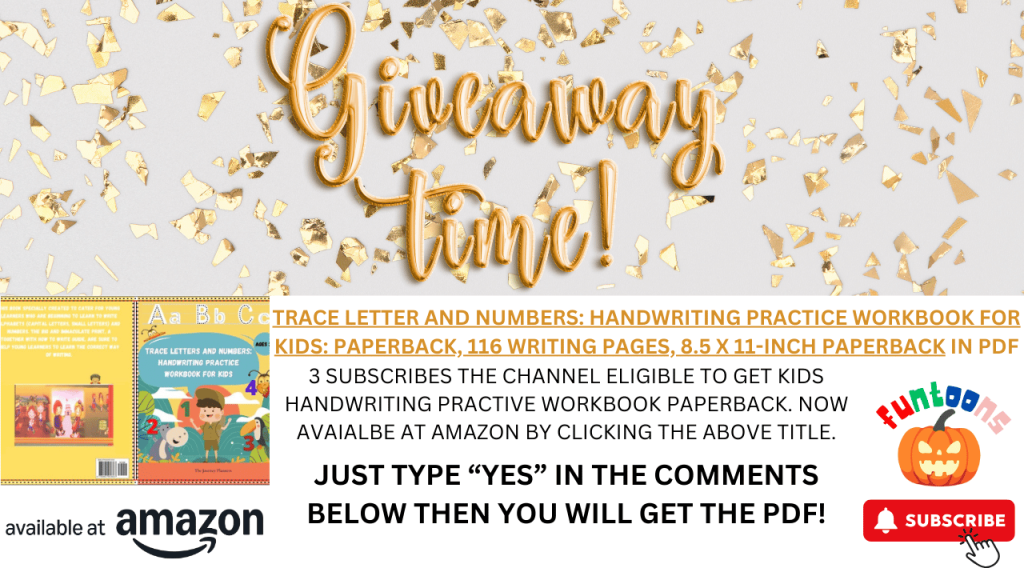FunToons is a kids-learning YouTube channel where kids learn to read and write through cartoon animation. It gives them fun and provides great learning and interest.

At FunToons111, we bring education and entertainment together through vibrant, animated videos designed specifically for kids. Our channel features engaging stories, fascinating facts, and fun adventures that make learning enjoyable for young minds. From exploring the wonders of nature to meeting amazing animals and discovering the world around us, FunToons111 offers a delightful blend of fun and knowledge.
Welcome to the best wildlife adventure of your life! You’re invited to watch 4K and 8K videos of the animal world, such as the elephant video, on FunToons111.
GIVEAWAY

If you manage to get 5 subscribers or more, that makes him/her eligible for an Amazon book in PDF format titled “Trace Letter and Numbers: Handwriting Practice Workbook for Kids: Paperback, 116 Writing Pages, 8.5 x 11-inch Paperback“ (https://www.amazon.com/dp/B0991FG8CF).
Please email me at hearsdrives4best@gmail.com when it gets done.
In addition to fantastic animal adventures, this full HD 4K high definition video also explores the astonishing 4K resolution footage. You are invited to watch stunning animal footage with a brief introduction to natural habitat. The Youtube link is down below:
Please subscribe like and share our channel below: FUNTOONS111
Baby Animals 4K – Amazing World of Young Animals | Relaxation Film
https://www.youtube.com/@funtoons111?sub_confirmation=1
20+ Interesting Facts You Should Know About Animals Video #interestingfacts #animals #amazing #hd
The Ocean Adventure 4K HD – Breathtaking Wildlife Film #theocean #adventure #4k #oceanlife #nature
WILD BIRDS & INSECTS 4K ULTRA HD VIDEO #4K #meetthebird #stunning #insect #wildlife
MEET THE ANIMAL & WILDLIFE SOUND 4K VIDEO ULTRA HD #4k #beautiful #animals #wildlife
LEARN BACKWARD COUNTING WITH ANIMALS EDUCATIONAL VIDEO 4K #learn #backwardcounting
MEET THE DEEP OCEAN CREATURE VIDEO ULTRA HD #animals #wildlife #adventure #4K #hd #hdr #nature
ANIMAL & WILDLIFE ADVENTURES 8K VIDEO ULTRA HD #8K
DEADLIEST ATTACK COMPILATION BY BIG CAT PUMA CHEETAH & TIGER
Meet the Animals | Fox | Educational Animated channel #meettheanimals #fox #funtoons #viralvideo
Meet The Birds Eagle Educational Animated Channel #meethebirds #eagle #educationalanimation #viral
Meet The Animals | DOG 4K Educational Animated Channel #meettheanimals #dog #educational #animated
Meet the Animals | Cat | Educational Animated Stories for Kindergarten 4K #meetheanimals #cat #viral
Meet the Animals Lion Wild Animals Educational Animated Stories 4K Kids #meettheanimals #Lion
Meet the Animals Dolphin Wild Animals Educational Animated Stories 4K Kids #meettheanimals #dolphin
Meet the Animals | Penguin | The Art of Living | Educational Video for Kindergarten #penguin #viral
Meet the Animals | Octopus | The Art of Living | Stories for Kindergarten #viral #octopus
Meet the Animals | African Elephant | The Art of Living | Stories for Kindergarten #meettheanimals
Meet the Animals | Cheetah | The Art of Living | Stories for Kindergarten #viral #viralvideo
Meet the Animals | Great White Shark | The Art of Living | Stories for Kindergarten #viral
Friends Adventure in The Jungle & Dino Story #friends #adventure #dinosaur #viral #viralvideo
Dino Diaries Unveiling the Lifestyles Video #dinosaur #dinosaurs #viral #viralvideo
Countryside Clash The Ultimate Car Race #viral #viralvideo
The Jungle Adventure #viral #jungle #junglebook
Fruits and their nutritional benefits for kids #viral #viralvideo
Join us on YouTube and let your children learn while they laugh with our colorful characters and exciting animations. Don’t miss out on the fun – subscribe to @FunToons111 today and ignite your child’s curiosity!
Visit us on YouTube: FunToons111
For more interesting blogs, click HERE
